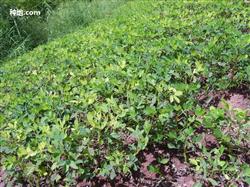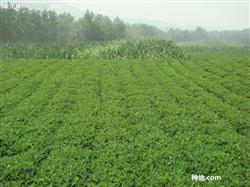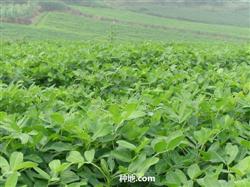How to increase the yield of peanuts

How can we make peanuts increase production? Please guide seed dressing with molybdenum fertilizer, phosphorus and potassium application, planting with shell, etc., are all good ways to increase peanut yield, and the following methods also play an important role in increasing peanut yield and income. The introduction is as follows: (1) the application of calcium fertilizer-Caso4 '2H2o ; peanuts are very sensitive to calcium and need more calcium, but the content of available calcium in sandy soil is low, which can not meet the nutritional needs of peanuts. Peanut calcium deficiency bud tip is easy to wither, there are many scars on the back of the old leaves, brown dead patches appear on both sides of the leaves, less pods, more empty shells and low yield. Generally speaking, about 20 kilograms of gypsum powder can be applied to each mu after the peanut flower needle is buried for 20 days. (2) scatter the earth and cover the needle: "all the fruit needles are covered with soil, and there will be a bumper harvest if you close your eyes." When a large number of fruit needles of peanuts were buried in the ground, some fruit needles were difficult to get into the soil and affected the yield because of the uneven ground under the plant. We should pick up the fine soil on the spot and sprinkle the cover needle on the plant, which can improve the penetration rate, fruit rate and full fruit rate of fruit needles. (3) remove the main stem: "the head of the peanut (the tip of the main stem) is removed to increase the fruit." Cutting off the main stem with a blade in the peanut rosette stage and leaving only one or two pairs of lateral branches can dwarf the plant, promote the strong stem, promote the branch, obviously change the plant potential and improve the photosynthetic efficiency, so as to increase the yield of peanut. The removal of the main stem should be carried out around noon on a windless sunny day to facilitate wound healing and reduce infection. (4) spray "photosynthetic solution": "photosynthetic solution" is sodium bisulfite aqueous solution. Sodium bisulfite is neither a nutrient nor a pest-killing pesticide, but a photorespiratory inhibitor. Spraying "photosynthetic liquid" at the flowering stage of peanut can reduce the photorespiration intensity of leaves and reduce the consumption of photosynthate (dry matter). The peanut was sprayed from the flowering stage and sprayed once every 8 days for a total of 3 times. Each mu with about 6 grams of sodium bisulfite, 50 kg of water spray. (5) Chemical control with paclobutrazol: paclobutrazol aqueous solution can be sprayed at seedling stage and full flowering stage. Spraying at seedling stage could promote root growth, enhance the ability of root system to absorb water and fertilizer, increase chlorophyll content in leaves and improve drought resistance of peanut, while spraying at full flowering stage could inhibit vegetative growth, reduce plant and promote strength, prevent lodging and promote pod, and improve pod setting rate and plumpness. In the seedling stage, when the main stem of peanut grew to 5 ~ 6 leaves, 30 kg of paclobutrazol 100ppm solution was sprayed per mu, and 40 kg of paclobutrazol 100ppm solution was sprayed 30 days after the first flowering. The use of paclobutrazol is easy to cause premature senility and leaf disease, so foliar topdressing and disease prevention should be strengthened. (6) foliar fertilizer spraying liquid: foliar fertilizer spraying uses less fertilizer and increases production, which is an effective measure to prevent premature senescence and promote yield. Spraying 1% urea + 0.3% potassium dihydrogen phosphate + 0.2% borax mixed fertilizer solution at the flowering stage and needling stage of peanut, and spraying about 50 kg per mu is appropriate. (7) Prevention and control of leaf spot: leaf spot does great harm to peanuts, which can make the leaves of the plant fall to the ground and inhibit photosynthesis, so that the pods are small, the grains are not full, and the yield is reduced by 10% and 20%. Carbendazim can be used to control peanut leaf spot. Use 25% carbendazim wettable powder 100g per mu and spray 50ml 60kg of water. Click to get more peanut planting technology click to get more grain and oil crop planting technology
- Prev

How to plant peanuts can increase production
How can peanuts be planted to increase production? Please guide summer peanut because of its high economic benefits, easy cultivation and management, conducive to land recycling and other advantages, and become the first choice for many growers. If you want to achieve high yield, you need to start with the following points. Select early maturing varieties with great potential for high yield.
- Next

What is the reason why peanut leaves suddenly turn white?
How to spray foliar fertilizer on peanuts? Please guide foliar spraying is a common fertilization method in production, suitable for peanut foliar topdressing and its application methods are as follows: 1. Urea in the middle and later stage of peanut growth, if the plant has the phenomenon of de-fertilizing, or continuous rainfall during the peanut growing period causes stagnant water in the field and fertilizer absorption in the root.
Related
- The first cup of black tea in spring, the flavor and history of tea gardens in Kenya, Africa
- The computer can not only choose potatoes, but also grow tea rice. AI will grow winter oolong tea champion.
- It is not only the inflated tea bitten by insects, but also engraved with the four seasons tea in Beipu.
- The Oriental Beauty Tea Festival in Zhuxian County takes the stage at the weekend to experience the plus-size feast of oil tea.
- & quot; Oriental Beauty Tea & Exploration of Emei in Hsinchu, the hometown of quot;
- The new variety of strawberry "Tainong 1" dessert is the first choice with mellow aroma. Crimson gorgeous
- History of Tea in Taiwan: from Wild Inner Mountain to Export Tea Garden
- Two types of Taiwan Oriental Beauty Black Tea won the British three-Star Award for Childhood Tea Xiang Zhang Jiaqi changed from pilot to champion tea maker.
- Banana species and varieties: the planting history of Taiwan Xianren banana and dwarf banana is long, is banana disease resistant?
- Coffee planting Technology: Qianjie Coffee from Seedling to harvesting

